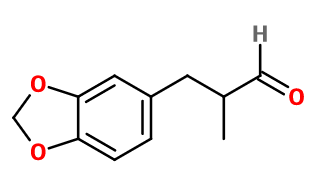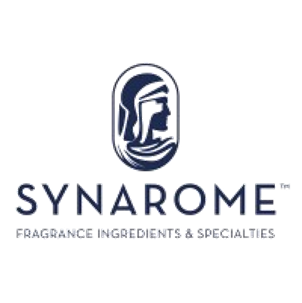Helional®
Synthétique
Marine > Ozonic > Juicy Fruits

Crédits photo: ScenTree SAS
Other names :
Aquanal® ; Heliobouquet® ; Heliogan® ; 3-(1,3-benzodioxol-5-yl)-2-methylpropanal ; Cetonial ; Floramelon ; Florial ; Neohelial ; Heliofresh ; Heliolan ; Helionix ; Heliopropanal ; Alpha-methyl-1,3-benzodioxole-5-propanal ; Alpha-methyl-1,3-benzodioxole-5-propionaldehyde ; 2-methyl-3-(3,4-methyenedioxyphenyl)propionaldehyde ; Alpha-methyl-3,4-(methylene dioxy) hydrocinnamaldehyde ; 3-(3,4-methylenedioxyphenyl)-2-methylpropanal ; Neohelial ; Ocean propanal ; Tropional
Volatility :
Heart/Base
Uses in perfumery :
Helional® is used in marine and juicy fruits accords, or for a light and ozonic note. Gives volume to a perfume or accord. Often used in functional fragrance.
Natural availability :
Helional® is not available in its natural state.
Year of discovery :
Discovered in 1958.
Patent N°3,008,968 published in february,11 1958 by Muus G.J. Beets and Harm van Essen for IFF
Other comments :
The smell of Helional® is less aldehydic than Cyclamen Aldehyde, less fruity than Melonal® and less marine than Calone®. Helional® is also less powerful than these three compounds.
Price Range :
€€
Stability :
Aldehydes may form diethylacetals in alcoholic perfumes, with no real impact on their smell.
Can react with Methyl Anthranilate to form a Schiff base that colors through time.
Can react with Methyl Anthranilate to form a Schiff base that colors through time.

Crédits photo: ScenTree SAS
- Molecular formula :
- C11H12O3
- Molecular Weight :
- 192,21 g/mol
- Density :
- 1,163
- Flash Point :
- 100°C
- Fusion Point :
- Donnée indisponible.
- Appearance :
- Colorless liquid
- Log P :
- 1,37
- Boiling Point :
- 282°C
- Detection Threshold :
- Donnée indisponible.
Synthesis route :
Helional® can be synthesized from Heliotropin by a condensation reaction with propanal, followed by a catalytic hydrogenation of the double bond that has formed.
Synthesis precursor :
May form a Schiff base with Methyl Anthranilate, called ''Corps Oranger ''.
Isomerism :
Helional® has an asymmetric carbon. The racemic mixture of the two enantiomers of the molecule is most often used. The (R) isomer is responsible for a fairly sweet aldehyde lily of the valley smell, while the (S) isomer is more ozonic, green and fruity.
- EINECS number :
- 214-881-6
- FEMA number :
- 4599
- JECFA number :
- 2212
- FLAVIS number :
- Donnée indisponible.
- Allergens :
- This ingredient does not contain any allergen.
- IFRA :
- This ingredient is restricted by IFRA
- Restriction type :
- RESTRICTION
- Cause of restriction :
- DERMAL SENSITIZATION AND SYSTEMIC TOXICITY
- Amendment :
- 49
- Comments :
- This ingredient is part of the Schiff base (Helional-methyl anthranilate (or Helioforte) - N°CAS :111753-60-7) and induces the application of IFRA regulations for 59,1% of the Schiff base usage. Please also refer to the IFRA Annex II for more information
- Quantitative limit on the use :
-
Cat.1 Cat.2 Cat.3 Cat.4 Cat.5A Cat.5B Cat.5C Cat.5D Cat.6 0,12 % 0,25 % 0,039 % 2,6 % 0,39 % 0,077 % 0,077 % 0,026 % 0,62 % Cat.7A Cat.7B Cat.8 Cat.9 Cat.10A Cat.10B Cat.11A Cat.11B Cat.12 0,077 % 0,077 % 0,026 % 0,15 % 0,15 % 0,62 % 0,026 % 0,026 % 12 % - Restriction type :
- RESTRICTION QRA
- Cause of restriction :
- SENSITIZATION
- Amendment :
- 47
- Comments :
- This ingredient is part of the Schiff base (Helional-methyl anthranilate (or Helioforte) - N°CAS : 111753-60-7) and induces the application of IFRA regulations for 59,1% of the Schiff base usage. Please also refer to the IFRA Annex II for more information
- Quantitative usage limits :
-
Cat.1 Cat.2 Cat.3 Cat.4 Cat.5 Cat.6 Cat.7 Cat.8 Cat.9 Cat.10 Cat.11 0,34 % 0,43 % 1,78 % 5,3 % 2,8 % 8,6 % 0,89 % 2 % 5 % 2,5 % Not Restricted
To learn more about IFRA's standards : https://ifrafragrance.org/safe-use/library
ScenTree is solely responsible for the information provided here.


